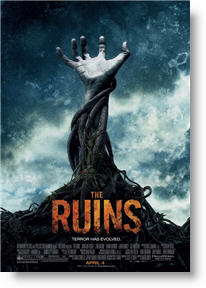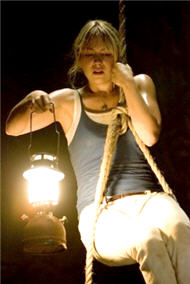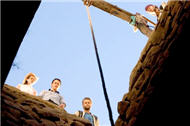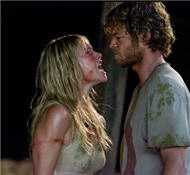The Ruins
 for strong violence and gruesome images, language, some sexuality and nudity.
for strong violence and gruesome images, language, some sexuality and nudity.
Reviewed by: Sara Bickley
CONTRIBUTOR
| Moral Rating: | Offensive |
| Moviemaking Quality: |
|
| Primary Audience: | Adults Mature-Teens |
| Genre: | Horror Adaptation |
| Length: | 1 hr. 31 min. |
| Year of Release: | 2008 |
| USA Release: |
April 4, 2008 (wide—2,500 theaters) |











Fear, Anxiety and Worry… What does the Bible say? Answer
| Featuring |
|---|
|
Jonathan Tucker Jena Malone Shawn Ashmore, Laura Ramsey, Joe Anderson, Sergio Calderón, Bar Paly, Dimitri Baveas, Jesse Ramirez |
| Director |
|
Carter Smith |
| Producer |
| Chris Bender, Stuart Cornfeld, Trish Hofmann, Ben Stiller |
| Distributor |
“Terror has evolved.”
A typical zombie movie and a typical slasher movie have a lot in common. Both involve a small group of people in an isolated setting trying to stave off a powerful, not-quite-human menace. The difference is focus. Zombie movies are about groups: outside, the zombies are legion; inside, the humans struggle to work together. Slasher movies are about individuals: one man is doing all the killing, and only one girl will outwit him and survive.
The menace in “The Ruins” is not a murdering madman or a zombie horde, but a colony of predatory plants. Yet the “slasher” and “zombie” plots are both represented; in fact, the transition between the two is a major part of the film.
The story begins conventionally enough, with four college students (Laura Ramsey, Jena Malone, Jonathan Tucker, and Shawn Ashmore) on vacation in Mexico. Another tourist, Mathias (Joe Anderson) plans to visit his brother at the titular ruins (a Mayan pyramid) and invites the four to accompany him.
Once there, they find themselves plunged into an impossible situation: Mathias’s brother and his team are missing, Mathias and Stacy (Ramsey) become injured while looking for him, and a group of natives have surrounded the pyramid, trapping the group at the top. The natives cannot be reasoned with—they speak neither English nor Spanish—and have demonstrated their willingness to kill.
The most interesting character in this first half of the movie is Stacy. She is strong-willed, proactive, and willing to take risks. If “The Ruins” were a slasher movie, Stacy would be the “final girl” and everyone else would, by default, be doomed.
All this, though, is before the evil plants show up. Stacy is unstoppable when dealing with things that are within her ken, but when something unknown appears, her emotional strength dries up and her sanity unravels. Being entirely self-reliant, she is helpless when confronted with horrors she cannot defeat by herself.
If Stacy is not the all-conquering “final girl,” then “The Ruins” is not a slasher movie, and the rest of the group is not necessarily doomed. The second half of the film draws the focus away from the individual and towards the group—away from the “slasher” plot and towards the “zombie” plot.
I don’t want to give too much away, but in the end, it transcends both plots. Where both an individual and a group have failed, a loving relationship succeeds. The only escape from certain death comes from one person’s self-sacrifice and another’s perfect trust: a surprisingly sophisticated spiritual message from an otherwise unassuming film.
The road to that message, however, is paved with assaults upon the sensibilities.
Foul language is heard frequently—there are about twenty F-words, a handful of scatological terms, and two profane uses of Jesus’ name. At one point a character says “thank God” with bitter sarcasm.
Accidental injuries and primitive field surgery are both major parts of the plot, and they are presented unflinchingly, with realistic gore.
There are only a few scenes of person-on-person violence, but they are particularly gruesome: in three separate scenes, characters (including a child) are shot with arrows and firearms. (However, the most disturbing death—a mercy killing by one of the main characters—occurs offscreen.)
Surprisingly, “The Ruins” contains no overtly occult element; though the natives regard it with a degree of superstitious awe, the hazardous plant colony seems to be of natural origin. (As the film’s tagline puts it: “Terror has evolved.”)
The opening scenes include casual drinking (one character’s drunken flirtation later becomes a plot point). Atop the pyramid, a bottle of liquor comes in handy for innocent applications: fueling torches and sterilizing wounds.
Early scenes feature winking sexual references (including an extended—and unfunny—double entendre joke) and brief nudity (both male and female) in the context of bathing and dressing. The female characters, typically for the genre, spend much of the film half-dressed: in revealing swimwear toward the beginning, and in distressed, shredded clothing toward the end.
Despite these major caveats, I was impressed by “The Ruins.” It has good performances from a mostly unknown cast, understated music and cinematography, and (apart from a couple of dodgy CGI shots) very convincing special effects. It tells its story efficiently, refuses to glamorize its horrors, and tweaks genre conventions just enough to turn a cliché premise into a fresh, surprising entertainment with some food for thought.
Violence: Extreme / Profanity: Heavy / Sex/Nudity: Heavy
See list of Relevant Issues—questions-and-answers.


Moral rating: Excellent! / Moviemaking quality: 3½
Moral rating: Very Offensive / Moviemaking quality: 1½
Moral rating: Very Offensive / Moviemaking quality: 4
I also have to admit that another reason I had gone to the movie is for Joe Anderson. I became a fan since watching him in “Across The Universe.” and I thought his performance was subtly brilliant. Even though he didn't have as much screen time as the others and his character spent most of the film wounded, he was able to gain the most emotion. Biased, maybe, but true.
Anyway, I loved this movie and loved that this isn't a typical “horror” film. This shows that you don't need a guy in a mask to be able to scare you during a movie. Can't wait for the DVD.
Moral rating: Average / Moviemaking quality: 4½
Moral rating: Offensive / Moviemaking quality: 3



My Ratings: Moral rating: Offensive / Moviemaking quality: 4